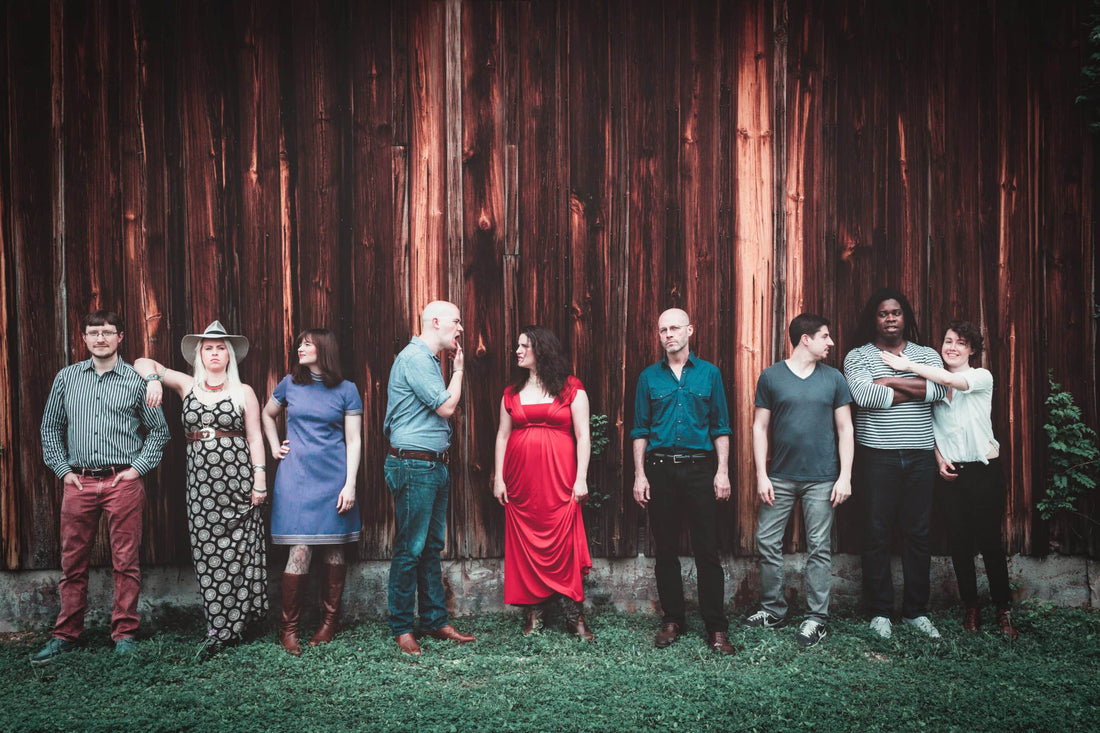
Stripsody was written during a period (mid -to late 20th century) when avant-garde music was at its peak — a period that produced new approaches like aleatoric music (where elements of the composition are left to chance or chosen by the performers), musique concrète (a type of musical collage combining sounds found in the world around us),[1] music notations that look more like modern art than notes on a staff, electronic music[2] and extended vocal techniques.
Most of those experiments sounded exactly like that: pieces that were interesting but not musically satisfying. While performances of early experiments aren’t likely to be included as part of your annual concert subscription, electronic music became and is still commonplace in films and on television. Extended vocal techniques not only appealed to composers and listeners but continued to flourish during the late 20th century.
Simple wordless vocalizations like “ooh” and “aah,” as well as more adventurous techniques like Schoenberg’s sprechstimme (a type of speech-song) had already been incorporated into Western orchestral and chamber music during the early 20th century.[3] Later in the century several prominent composers integrated extended vocal techniques into their compositions. For example Luciano Berio, a leading avant-garde composer who was married to vocalist Cathy Berberian, wrote Sinfonia for orchestra and eight amplified voices requiring vocalists to speak, whisper or shout words.[4] Composer George Crumb became famous for his unconventional music notations and extended instrumental and vocal techniques that produced a variety of unusual timbres. György Ligeti, recognizable for his music featured in the 1968 film 2001: A Space Odyssey, tried to eliminate the differences between vocal and instrumental sounds and Meredith Monk, notable for her vocal innovations, created a wide range of extended techniques that were first used during the 1960s and 70s.
One of the most influential vocalist/composers of our time is Joan Linda La Barbara. La Barbara can sing two or more pitches simultaneously[5] and is credited with promoting a new vocabulary of vocal sounds including trills, whispers, cries, sighs and inhaled tones. During the early 1970s she focused on vocal sounds rather than traditional pitches as the raw material for music, and explored techniques like circular breathing[6] and how to produce various timbres on a single pitch. By the mid-1970s La Barbara was writing structured compositions, some of which included electronics and layered vocal sounds. She has continued performing, composing and recording well into the 21st century.
Many contemporary composers are using these types of techniques to create absorbing musical experiences and several avant-garde groups like The Crossing (Philadelphia, PA) and Roomful of Teeth (North Adams, MA) are currently showcasing new vocal music. The Teeth describe themselves as a “vocal project dedicated to reimagining the expressive potential of the human voice. Through study with masters from vocal traditions the world over, the eight-voice ensemble continually expands its vocabulary of singing techniques….[The ensemble has] studied with some of the world’s top performers and teachers in Tuvan throat singing, yodeling, Broadway belting, Inuit throat singing, Korean P’ansori, Georgian singing, Sardinian cantu a tenore, Hindustani music, Persian classical singing and Death Metal singing.”[7]
The acclaimed a cappella group Volti (San Francisco, CA) often employs extended vocal techniques such as microtones (intervals smaller than a semitone), fragmented texts, sounds based on vowels and/or consonants and purely vocal sounds. Founder and Artistic Director Robert Geary’s goal is to “use new music to open up sound spaces and horizons in your head; to help audiences see the potential for choral music….As for extended techniques we look back to Stockhausen, Berio, Ligeti, Cage, Penderecki and others. At this point I feel like extended techniques are widely used and not exclusively with avant-garde music…Once we got over the idea that music and singing were salon and church oriented, the palette of vocalism broadened.”[8]
According to Geary most of the compositions Volti performs are “edgy” although the repertoire includes more traditional pieces as well. The ensemble aims to intrigue audiences by avoiding the usual “safety nets” of choral music — religious contexts, familiar poetry, instrumental support, functional harmony, traditional vocal techniques — in order to move audiences beyond their usual comfort zones.
Extended vocal techniques help composers create diverse sound worlds that stretch the ways listeners think about music. The best of these compositions can be surprising, adventurous, inventive, dramatic, haunting, soothing, jarring, moving—in other words, as engaging as any other style of music. This is vocal music with a different vocabulary where musical shapes and harmonies are often more important than actual word meanings and where unusual effects like fragmented texts, slides and yelps are transformed into striking vocal textures.
Using Stripsody as a starting point we can all celebrate extended vocal techniques by saying, once more with feeling: Honk! Bonk! Boing! Blomp! Ooh! Aah! And a cheery Woo, woo![9]
 A section of Stripsody. Courtesy of Wikimedia Commons/Fplanas24.
A section of Stripsody. Courtesy of Wikimedia Commons/Fplanas24.
Recommended Volti Recordings (Innova CDs):
House of Voices
A well-chosen program of unaccompanied choral music by emerging and established composers that is challenging, stimulating and always intriguing. The music is accessible with timbres, harmonies and textures that will draw you back for repeated hearings.
One of the disc’s highlights is Ted Hearne’s five-movement Privilege. During the first movement Hearne turns part of the text into a Klangfarbenmelodie — Schoenberg’s technique for dividing a musical line or melody among several instruments or voices instead of assigning it to one instrument.

The Color of There Seen From Here
Volti’s most recent disc includes Tonia Ko’s From Ivory Depths, a composition that engages your mind and ears through the use of textured soundscapes; Mark Winges’ complex and intriguing All Night that is rich, dense and sparse — all at the same time; and Lithuanian composer Žibuoklė Martinaitytė’s soft and atmospheric The Blue of Distance that washes over you with speech sounds, humming and open vowels.
[1]The first piece written using this technique, Pierre Schaeffer’s 1948 composition Etude aux chemins de fer was created entirely from sounds found at a train station. For more about found sounds see “Ear Flaps Up: How I Learned to Stop Worrying and Love the Brahms” in issue #118 of Copper.
[2]The Moog synthesizer was used to create new pieces and reinterpret older compositions. One of the most popular LPs of electronic music for general audiences was Wendy Carlos’ Switched on Bach (1968).
[3]Some of the best known examples of wordless vocalizations include the original version of Rachmaninoff’s Vocalise for piano and solo voice (1915), the conclusion to Ravel’s Daphnis et Chloe (1912), the “Humming Chorus” from Puccini’s Madama Butterfly (1904), the “Neptune” movement of Holst’s The Planets (1916) and the wordless introduction to Heitor Villa-Lobos’ “Aria” from Bachianas Brasileiras No. 5 (1930-45).
[4]Sinfonia was written in 1968 to celebrate the 125th anniversary of the New York Philharmonic.
[5] A technique called multiphonics.
[6] Producing a continuous tone without interruption by breathing in through the nose while simultaneously pushing air out through the mouth.
[7]Description from Roomful of Teeth website: roomfulofteeth.org
[8] Geary founded the San Francisco Chamber Singers in 1979 — an ensemble with the goal of discovering, creating and performing new, unaccompanied vocal music. The chorus started focusing entirely on contemporary music during the 2003-2004 season and because the name of the ensemble implied looking back at older repertoire instead of forward to new works, SFCS changed its name to Volti — a reference to the Italian musical term “volti subito” meaning “turn [the page] quickly, look ahead!”
[9] For some do it yourself experiments refer to MouthSounds: How to Whistle, Pop, Boing, and Honk… for all occasions and then some (Workman Press, 2004).
Header image of Roomful of Teeth courtesy of Roomful of Teeth/Bonica Ayala of Bonica Ayala Photography.



